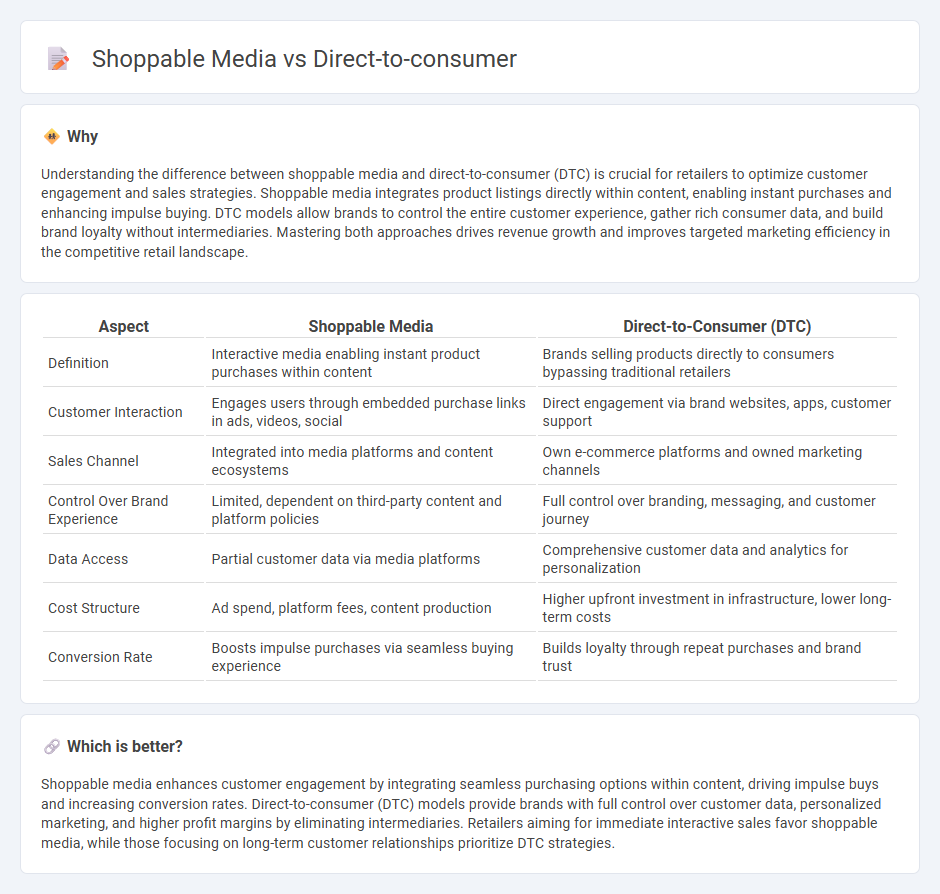
Shoppable media integrates interactive elements within content, enabling consumers to purchase products seamlessly while engaging with advertisements, offering a dynamic retail experience. Direct-to-consumer (DTC) models bypass traditional retail channels, fostering closer brand-to-customer relationships and enabling personalized marketing strategies. Explore how these innovative approaches are reshaping the future of retail.
Why it is important
Understanding the difference between shoppable media and direct-to-consumer (DTC) is crucial for retailers to optimize customer engagement and sales strategies. Shoppable media integrates product listings directly within content, enabling instant purchases and enhancing impulse buying. DTC models allow brands to control the entire customer experience, gather rich consumer data, and build brand loyalty without intermediaries. Mastering both approaches drives revenue growth and improves targeted marketing efficiency in the competitive retail landscape.
Comparison Table
| Aspect | Shoppable Media | Direct-to-Consumer (DTC) |
|---|---|---|
| Definition | Interactive media enabling instant product purchases within content | Brands selling products directly to consumers bypassing traditional retailers |
| Customer Interaction | Engages users through embedded purchase links in ads, videos, social | Direct engagement via brand websites, apps, customer support |
| Sales Channel | Integrated into media platforms and content ecosystems | Own e-commerce platforms and owned marketing channels |
| Control Over Brand Experience | Limited, dependent on third-party content and platform policies | Full control over branding, messaging, and customer journey |
| Data Access | Partial customer data via media platforms | Comprehensive customer data and analytics for personalization |
| Cost Structure | Ad spend, platform fees, content production | Higher upfront investment in infrastructure, lower long-term costs |
| Conversion Rate | Boosts impulse purchases via seamless buying experience | Builds loyalty through repeat purchases and brand trust |
Which is better?
Shoppable media enhances customer engagement by integrating seamless purchasing options within content, driving impulse buys and increasing conversion rates. Direct-to-consumer (DTC) models provide brands with full control over customer data, personalized marketing, and higher profit margins by eliminating intermediaries. Retailers aiming for immediate interactive sales favor shoppable media, while those focusing on long-term customer relationships prioritize DTC strategies.
Connection
Shoppable media integrates interactive content with e-commerce, enabling consumers to purchase products directly through ads and social platforms, which aligns seamlessly with direct-to-consumer (DTC) strategies by eliminating intermediaries and enhancing customer engagement. This connection boosts conversion rates by providing a frictionless shopping experience that leverages tailored data from DTC channels to personalize marketing efforts. Retailers adopting shoppable media in DTC models benefit from real-time analytics, streamlined sales funnels, and stronger brand-consumer relationships.
Key Terms
Brand Ownership
Direct-to-consumer (DTC) brands maintain full control over customer data, brand messaging, and pricing strategies, allowing for a personalized and consistent brand experience. Shoppable media integrates purchasing options directly into content platforms, enabling seamless transactions but often sharing control and data with third-party platforms. Explore how balancing brand ownership and consumer engagement shapes marketing strategies.
Conversion Path
Direct-to-consumer (DTC) strategies streamline the conversion path by engaging customers directly through personalized marketing and optimized user experiences on proprietary platforms. Shoppable media integrates seamless purchasing options within content, reducing friction in the conversion funnel by allowing consumers to buy products instantly from ads or social posts. Explore these approaches further to understand how they uniquely impact conversion efficiency and customer journey optimization.
Customer Data
Direct-to-consumer (DTC) models leverage first-party customer data to create personalized marketing experiences and improve product offerings through direct engagement. Shoppable media integrates interactive content with e-commerce functionalities, capturing behavioral data to optimize conversion rates and refine audience targeting. Explore how combining DTC strategies and shoppable media can revolutionize customer data utilization.
Source and External Links
Direct-to-consumer - Direct-to-consumer (DTC) is a business model where brands sell products directly to customers, bypassing third-party retailers or wholesalers, typically through online platforms, allowing closer relationships with consumers and higher profit margins.
Direct to Consumer (DTC) Sales: Tips and Examples - DTC brands control product presentation, marketing, shipping, and customer data directly, enabling personalized marketing, stronger customer relationships, and avoiding intermediaries for better profit margins.
What Is Direct-to-Consumer? Everything You Need To Know - The DTC model involves brands selling directly to customers via digital channels, managing the entire fulfillment process, focusing on customer experience, and often leveraging loyalty programs and user-generated content to build communities and retain customers.
 dowidth.com
dowidth.com